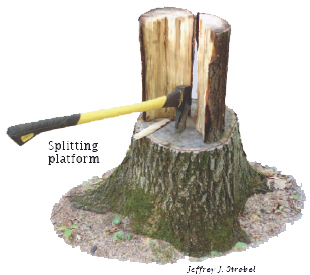Splitting wood by hand with a maul is one of the few tasks I look forward to and undertake with a great deal of satisfaction. Whether you are an old hand at splitting wood or not, there are a few simple techniques worth sharing that will make your work safe and efficient.
A good place to start is deciding on what kind of tool to use. There are a number of specialty splitting tools for sale, but I would like to focus on mauls and specifically the “monster” or “mega” maul in comparison to the traditional maul. Many have converted to the former mostly because its shape (20-30 degree splitting heads compared to 5-15 degree heads for a traditional maul) splits wood very efficiently and reduces the chances it will get stuck in a piece. Additionally, they can be stood on end due to the large splitting head, reducing the time and energy spent bending over to pick up the maul. The big drawback is that they tend to weigh a few pounds more than traditional mauls.
The next thing to consider is when to split the wood. Some say splitting wood right after the tree has been felled and the wood is green is the fastest and easiest way to get it into your woodbox. Splitting it earlier means the wood will dry faster, as smaller pieces lose moisture more quickly than larger pieces, especially if the larger pieces still have a lot of bark. Some folks like to fell trees in the winter and then drag them out of the woods for bucking (or cutting the stem into the right length for your wood stove or furnace) and splitting when the weather is better. This strategy works just fine for getting wood to the stove the following winter if the bucking and splitting takes place in early spring.
With the tree bucked up, let’s talk about getting those rounds split into a useable size. Splitting wood on a chopping block (a stump or another round of wood) will reduce the chance of striking a rock or your foot. Cut your chopping block to a height so that the angle between the piece to be split and your maul is 90 degrees when the maul strikes the wood. This will maximize your mauls splitting force, and improve your chances of getting a clean strike.
Deciding where to strike the piece is the next step. If there already is a crack in the wood, then by all means utilize that as a starting point for splitting. If the piece has a knot at one end, then put the knot on the bottom for easier splitting. Some recommend splitting right down the middle of the knot, which I do, but after I have reduced the entire piece down in size by at least half. For wood that is too big to split in one strike, I like to start at one edge and work my way across the center of the piece with successive strikes until the piece splits in two. Another way to address larger pieces is to “peel” them. This process involves striking the piece near the edge to remove a small portion. You then work your way around the piece splitting off more of the edge until you are left with just a more manageable center piece. For particularly tough pieces, make your life easier by creating a crack with a vertical chainsaw cut down the middle of the piece.
I am fortunate to be able to take a philosophical approach to very difficult pieces of wood. These include wood with large branches and forks. You see, I work in a woodlot with an abundance of big oak trees with clear stems and few branches. These trees produce some of the easiest cut and split firewood, and are a joy to work with. Since I can produce enough firewood from trees like these, I can leave the worst pieces for the mice and squirrels to make homes in. If you are not as lucky and need everything you can get out of the forest, then try bucking the tougher pieces to a shorter length than you would normally to make the job easier. And don’t be afraid to use your chainsaw to split forks and cut branches off.
Män med ED som också testar lågt för testosteron kan erbjudas ett hormonboost, ofta i form av en gnidningsgel applicerad dagligen, förutom ett ED-läkemedel. I den senaste studien tog hälften av dem Cialis och använde en daglig testosterongel, medan de andra tog Cialis och använde en placebogel https://xn--stenhrd-ixa.net/cialis/.
